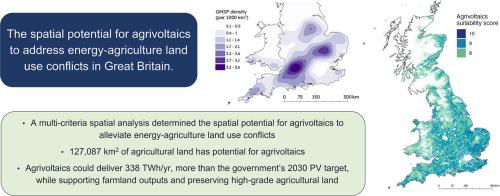农业光伏在解决英国能源与农业用地冲突方面的空间潜力
IF 11
1区 工程技术
Q1 ENERGY & FUELS
引用次数: 0
摘要
地面太阳能公园提供了急需的低碳电力,但它们的发展与其他土地用途(如农业)的冲突日益加剧,它们对农业景观的视觉侵入和对粮食生产的可能影响正在引起公众越来越多的关注。在整个欧洲,农业发电已经被证明可以同时生产粮食和电力,但它在缓解英国土地使用冲突方面的潜力还有待探索。本研究量化了现有太阳能园区与不同等级农业用地重叠的程度,并预测了未来光伏-农业用地可能发生冲突的地方。根据专家利益相关者的见解,确定了农业发电可以缓解这些冲突的地方,揭示了这项技术理论上可以产生338太瓦时/年,同时保持20,272平方公里高等级农田的产量。一些农业光伏设计减少了蒸发水分的损失,这项研究强调了这将有利于面临水资源短缺的地区。研究了不同耕地分类的空间适宜性。这项研究首次对大规模光伏基础设施的潜力进行了空间评估,以协同发展,而不是与英国的农业相冲突。本文章由计算机程序翻译,如有差异,请以英文原文为准。

The spatial potential for agrivoltaics to address energy-agriculture land use conflicts in Great Britain
Ground-mounted solar parks provide much needed low-carbon electricity, but their development is increasingly conflicting with other land uses, such as agriculture, and their visual intrusion on agricultural landscapes and possible impact on food production is causing increasing public concern. Agrivoltaics has been proven across Europe to produce food and electricity concomitantly, but its potential to alleviate land use conflicts in Great Britain is yet to be explored. This study quantifies the extent that existing solar parks overlap with different grades of agricultural land, and forecasts where PV-agriculture land use conflicts may occur in the future. Where agrivoltaics could alleviate these conflicts is determined based on expert stakeholder insights, revealing that this technology could theoretically generate 338 TWh/year while maintaining outputs from 20,272 km2 of high-grade farmland. Some agrivoltaic designs reduce evaporative water loss, and this study highlights where this would be beneficial for regions facing water scarcity. The spatial suitability of different cropland classifications is also shown. This study provides the first spatial assessment of the potential for large scale PV infrastructure to be developed in synergy rather than in conflict with agriculture in Great Britain.
求助全文
通过发布文献求助,成功后即可免费获取论文全文。
去求助
来源期刊

Applied Energy
工程技术-工程:化工
CiteScore
21.20
自引率
10.70%
发文量
1830
审稿时长
41 days
期刊介绍:
Applied Energy serves as a platform for sharing innovations, research, development, and demonstrations in energy conversion, conservation, and sustainable energy systems. The journal covers topics such as optimal energy resource use, environmental pollutant mitigation, and energy process analysis. It welcomes original papers, review articles, technical notes, and letters to the editor. Authors are encouraged to submit manuscripts that bridge the gap between research, development, and implementation. The journal addresses a wide spectrum of topics, including fossil and renewable energy technologies, energy economics, and environmental impacts. Applied Energy also explores modeling and forecasting, conservation strategies, and the social and economic implications of energy policies, including climate change mitigation. It is complemented by the open-access journal Advances in Applied Energy.
 求助内容:
求助内容: 应助结果提醒方式:
应助结果提醒方式:


